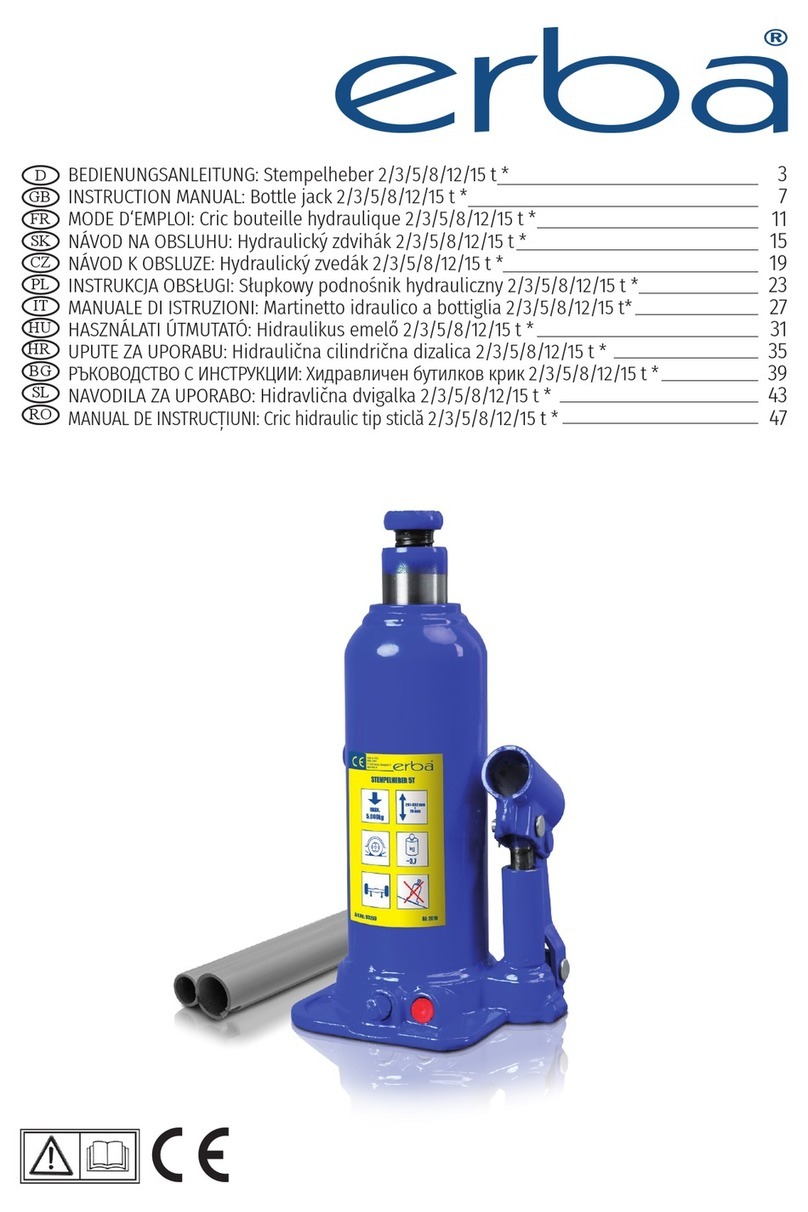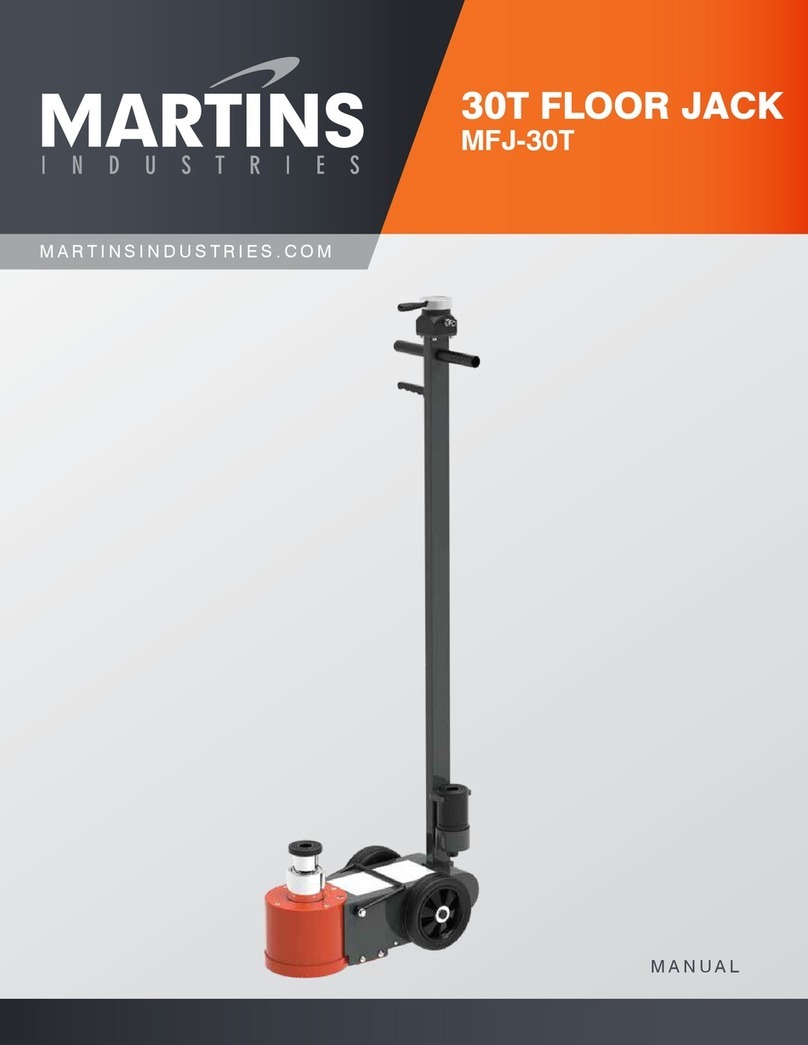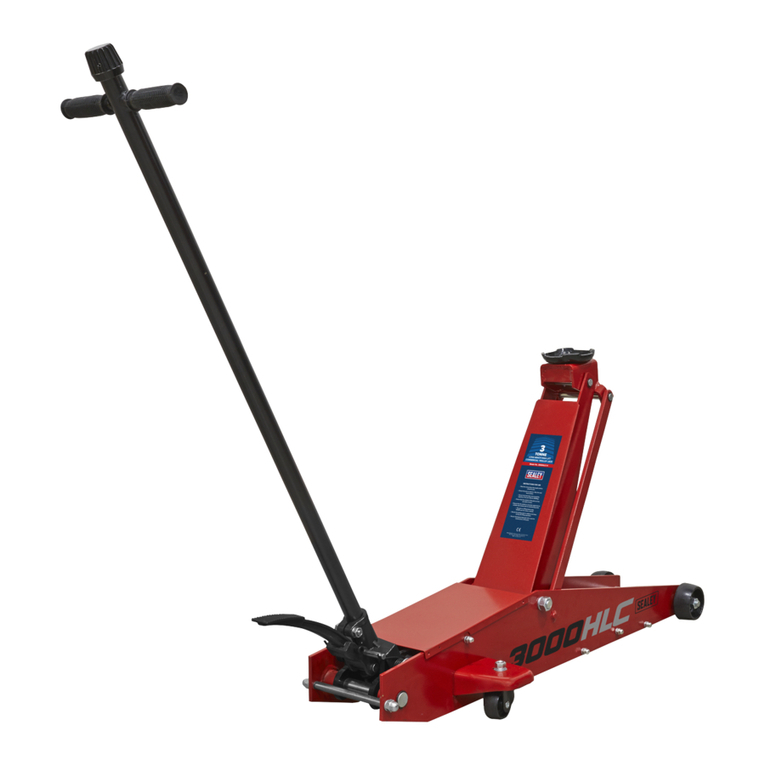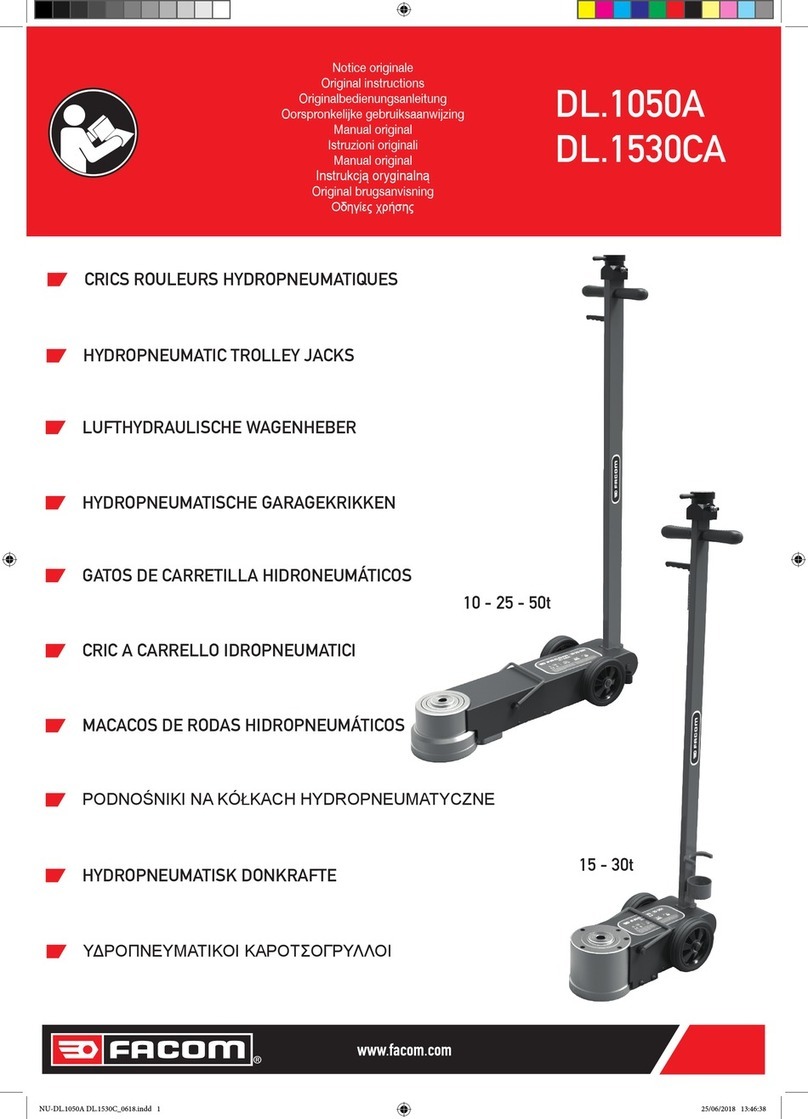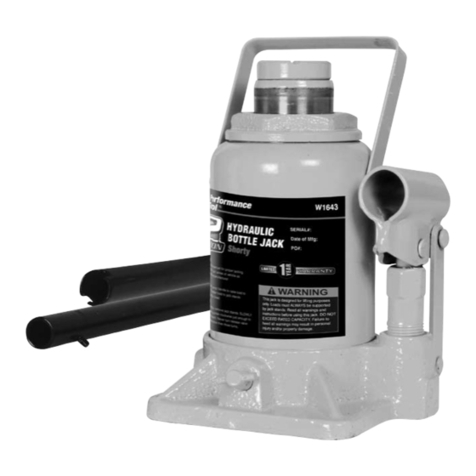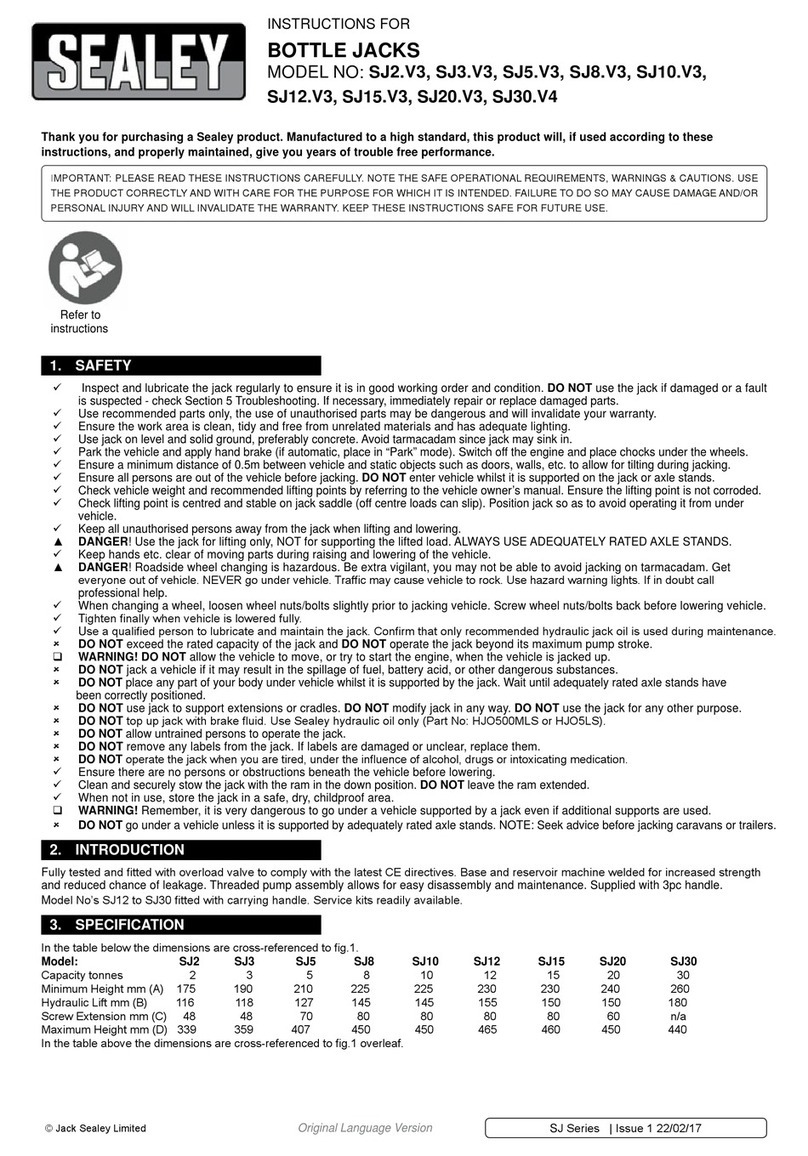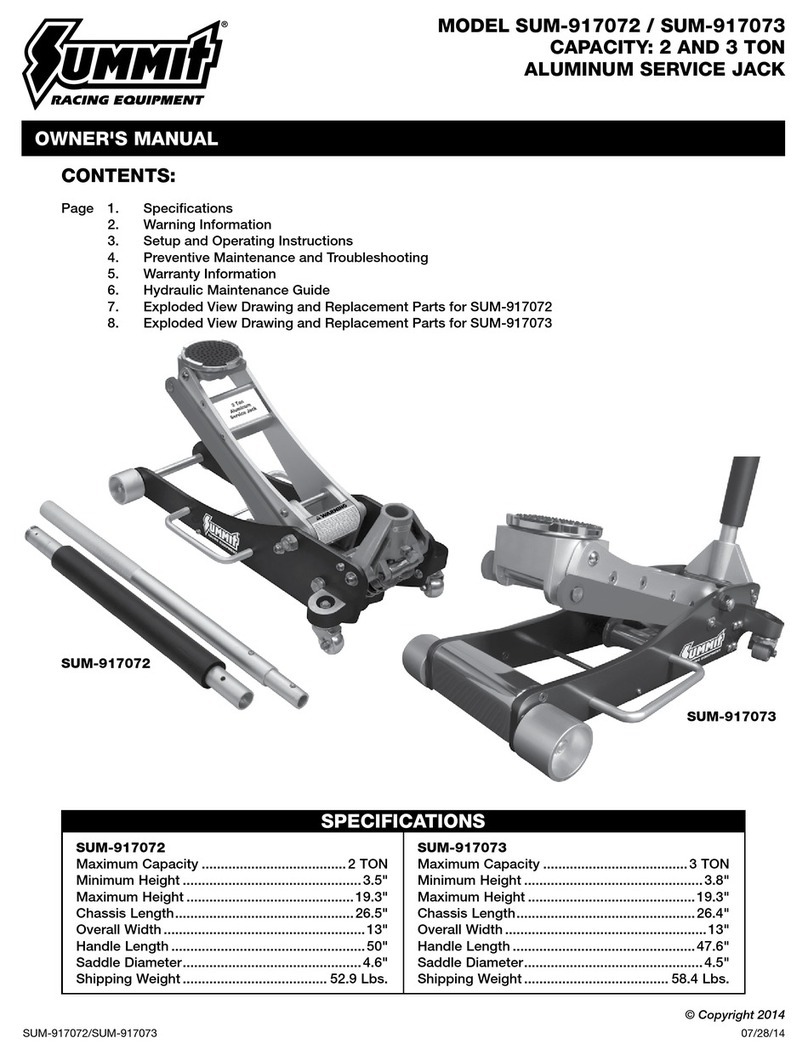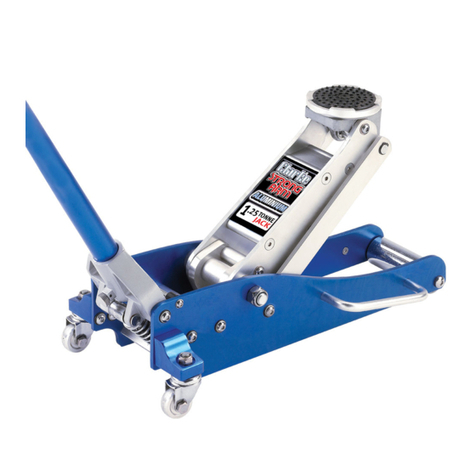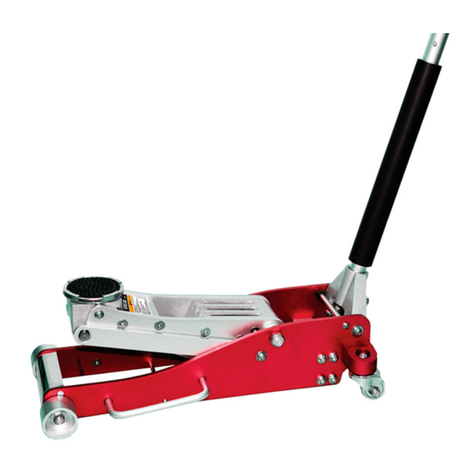Hercules HCRG-JACK48 User manual

SPECIFICATIONS...............................................................................................2
IMPORTANT SAFETY INFORMATION ....................................................................3
UNPACKING AND ASSEMBLING JACK ................................................................3
Unpacking Carton ..........................................................................................3
Testing Operation ...........................................................................................3
OPERATING JACK .............................................................................................4
Preparing Work Area .......................................................................................4
Lifting Vehicle .................................................................................................5
Working on Vehicle .........................................................................................5
Lowering Vehicle.............................................................................................6
MAINTENANCE AND STORAGE ..........................................................................7
Lubricating......................................................................................................7
Cleaning.........................................................................................................7
Storage ...........................................................................................................7
Repairing Jack................................................................................................7
SPECIFICATIONS
Working Load Limit 1050 KG
Height Lowered 110 mm
Height Raised 1050 mm
Handle Length 870 mm
Total Weight: 12.5KG

IMPORTANT SAFETY INFORMATION
The use of a vehicle jack has inherent dangers to avoid risk of personal injury or property
damage make sure you are fully aware of the operating instructions for this product, the
recommendations in the vehicle owners manual for jacking of your vehicle prior to lifting
the vehicle. Do not exceed maximum lifting capacity of this jack. This jack is intended
for automotive use only. Be aware that large or heavy vehicles may exceed jack’s stated
capacity check vehicle owners manual or contact the vehicle manufacturer. Do not use
for vehicle maintenance or wheel removal, a high lift jack is designed for aiding in vehicle
recovery and winching. Never use to raise any structure or building, Do not lift any human load
and do not get under a raised vehicle.
Unpacking Carton
Place carton in a clear, open area such as garage floor. Remove jack from carton. No pre-
assembly is required so please take this time to familiarise yourself with the jack, its function and
these operating instructions
Testing Operation
Briefly test jack operation as follows
BEFORE using to lift any Load.
Step 1 place jack on a firm level
surface.
Step 2 place ratchet control lever in
the lifting position
Step 3 raise the lifting nose by gently
pumping the handle up and down.
The jack will click in and out as the
lifting pins engage and disengage
with the jack with each up and down
stoke of the jack.
Danger: the handle becomes
weight bearing during the lifting
and lowering process.
Caution: this jack must have a
minimum load of 50 kg on it to
lower step by step, otherwise the
lifting mechanism will slide down
to the base plate dropping your
vehicle.
UNPACKING AND ASSEMBLING JACK

Preparing Work Area
Before using jack, it is important to prepare work area properly. Follow this procedure each time
the jack is used to help prevent property damage and or serious injury.
Thoroughly inspect jack for damage or wear before each use. Briefly test operation of
unloaded jack before using to lift any load. If jack is damaged or is malfunctioning DO NOT LIFT
ANY LOAD until the problem is corrected.
Consult vehicle owner’s manual for safety precautions, jacking procedure, vehicle weight,
recommended jack type, and location of jack support areas on vehicle.
The working load limit of the jack is 1050 kg. NEVER EXCEED WORKING LOAD LIMIT OF JACK.
Consider the load the vehicle is carrying this can greatly increase the overall weight of the
vehicle.
Clear children and others from work area before moving or lifting vehicle. Another adult should
be nearby for extra safety and assistance but must be clear of vehicle as it is moved or lifted.
No person should remain in a vehicle that is being lifted moved or lifted, No person should
enter a vehicle which is supported by a jack or by vehicle support stands. No person should
lean into a vehicle which is supported by a jack or by vehicle support stands.
Clear obstructions from work area. Working in tight or cluttered work areas is dangerous.
Be sure jack and vehicle are on solid, dry, and level ground so upright is pointing straight
up. Uneven sloped or soft surfaces create hazardous working conditions and dangerously
impeded the function of the jack.
With vehicle in proper position, set vehicle’s parking brake or emergency brake and put
gearshift in park (manual transmissions should be placed in lowest gear). TURN VEHICLE
IGNITION OFF AND TO THE “LOCK” POSITION making sure steering wheel locks.
Do not rely on vehicle transmission or brakes to hold vehicle in position. Chock all wheels of
vehicle not being lifted off the ground to prevent vehicle rolling. Using wedge-shaped blocks
that tire cannot roll over, position one chock tight against the tyre in both forward and reverse
rolling paths.
The use of a high lift Jack has
inherent dangers to avoid risk
of personal injury or property
damage make sure you are
fully aware of the operating
instructions for this product,
the recommendations in
this manual can not cover
all eventualities this Jack is
designed and intended for
use by properly trained and
experienced personnel. If
you are not familiar with the
proper and safe operation
of a High Lift Jack, do not
use until proper training
and knowledge has been
obtained.
OPERATING JACK
OPERATING JACK
The use of a high lift Jack has inherent dangers to avoid risk of personal injury or property damage make
sure you are fully aware of the operating instructions for this product, the recommendations in this manual
can not cover all eventualities this Jack is designed and intended for use by properly trained and
experienced personnel. If you are not familiar with the proper and safe operation of a High Lift Jack, do not
use until proper training and knowledge has been obtained.
Preparing Work Area
Before using jack, it is important to prepare work area properly. Follow this procedure each time the jack is
used to help prevent property damage and or serious injury.
1.) Thoroughly inspect jack for damage or wear before each use. Briefly test operation of unloaded jack
before using to lift any load. If jack is damaged or is malfunctioning DO NOT LIFT ANY LOAD until the
problem is corrected.
2.) Consult vehicle owner’s manual for safety precautions, jacking procedure, vehicle weight, recommended
jack type, and location of jack support areas on vehicle.
3.) The working load limit of the jack is 1050 kg . NEVER EXCEED WORKING LOAD LIMIT OF JACK.
4.) Consider the load the vehicle is carrying this can greatly increase the overall weight of the vehicle.
5.) Clear children and others from work area before moving or lifting vehicle. Another adult should be
nearby for extra safety and assistance but must be clear of vehicle as it is moved or lifted.
6.) No person should remain in a vehicle that is being lifted moved or lifted, No person should enter a
vehicle which is supported by a jack or by vehicle support stands. No person should lean into a vehicle
which is supported by a jack or by vehicle support stands.
7.) Clear obstructions from work area. Working in tight or cluttered work areas is dangerous.
Handle
Upright
Base
Lifting nose
Lifting pins
Ratchet Control
lever

Plan location of jack, make sure jack will be contacting a flat area of vehicle. Consult vehicle
owner’s manual for location of jack support areas. Never use on curved or tubular surfaces as
these can more easily slide of the jack causing the load to fall leading too property damage
personal injury or even death.
Lifting a vehicle using a jack can be dangerous. Follow all instructions
and precautions below. Do not lift any vehicle with its engine running
or start any vehicle that is supported by jack or jack stands.
With lifting nose completely lowered, place jack into position beneath
a suitable jack support area of vehicle.
Engage the jack by pulling up on the ratchet control lever
Pump jack handle slowly until lifting nose just begins to contact support area on underside of
vehicle.
Inspect position of lifting nose beneath support area, making sure it is centered and properly
engaging support area.
Check the base is firmly on the ground capable of holding the weight. A plate (not included)
of material able to hold the weight can be used to spread the load over a larger area.
The load will be lifted on each down stroke of the handle; the load will push up against the
handle on each stroke, keep head and body away from the path of the handle, if your hands
should slip off the handle it may fly up causing serious injury or death.
Continue pumping handle slowly with both hands on the handle until vehicle is lifted to desired
height.
Pay attention to lifting nose position as vehicle is being raised to be sure there is no danger of
support area slipping off.
Any vehicle being supported by a jack creates a potentially hazardous working environment.
Do not try to move a vehicle that is supported by a jack and that no person should place
any portion of their body under a vehicle that is supported by a jack. Be careful of forces
applied to vehicle such as torque on a nut or bolt. These forces could cause vehicle to
become unstable. Do not turn vehicle ignition or attempt to start any vehicle supported by
jack.
Lifting Vehicle
Working on Vehicle
8.) Be sure jack and vehicle are on solid, dry, and level ground so upright is pointing straight up. Uneven
sloped or soft surfaces create hazardous working conditions and dangerously impeded the function of
the jack.
9.) With vehicle in proper position, set vehicle ’s parking brake or emergency brake and put gearshift in park
(manual transmissions should be placed in lowest gear). TURN VEHICLE IGNITION OFF AND TO THE
“LOCK” POSITION making sure steering wheel locks.
10.) Do not rely on vehicle transmission or brakes to hold vehicle in position. Chock all wheels of vehicle not
being lifted off the ground to prevent vehicle rolling. Using wedge-shaped blocks that tire cannot roll
over, position one chock tight against the tyre in both forward and reverse rolling path s.
11.) Plan location of jack, make sure jack will be contacting a flat area of vehicle. Consult vehicle owner’s
manual for location of jack support areas. Never use on curved or tubular surfaces as these can more
easily slide of the jack causing the load to fall leading too property damage personal injury or even
death.
Lifting Vehicle
Lifting a vehicle using a jack can be dangerous. Follow all instructions and
precautions below. Do not lift any vehicle with its engine running or start any
vehicle that is supported by jack or jack stands.
1.) With lifting nose completely lowered, place jack into position beneath a
suitable jack support area of vehicle.
2.) Engage the jack by pulling up on the ratchet control lever
3.) Pump jack handle slowly until lifting nose just begins to contact support area on underside of vehicle.
4.) Inspect position of lifting nose beneath support area, making sure it is centered and properly engaging
support area.
5.) Check the base is firmly on the ground capable of holding the weight. A plate (not included) of material
able to hold the weight can be used to spread the load over a larger area.
6.) The load will be lifted on each down stroke of the handle; the load will push up against the handle on
each stroke, keep head and body away from the path of the handle, if your hands should slip off the
handle it may fly up causing serious injury or death.
7.) Continue pumping handle slowly with both hands on the handle until vehicle is lifted to desired height.
8.) Pay attention to lifting nose position as vehicle is being raised to be sure there is no danger of support
area slipping off.
Working on Vehicle
Any vehicle being supported by a jack creates a potentially hazardous working environment.
Do not try to move a vehicle that is supported by a jack and that no person should place any portion of
their body under a vehicle that is supported by a jack. Be careful of forces applied to vehicle such as
torque on a nut or bolt. These forces could cause vehicle to become unstable. Do not turn vehicle ignition
or attempt to start any vehicle supported by jack.

Before lowering vehicle, be sure area under and near vehicle is
clear of all persons and obstructions.
With jack handle in upright position push down on the ratchet
control lever, the jack handle will move rapidly up if the ratchet
control level is placed in the lowering position with the handle
not properly stowed in the upright position.
The load will be lowered on each up stroke of the handle; the load will push up against the
handle on each stroke, keep head and body away from the path of the handle, if your hands
should slip off the handle it may fly up causing serious injury or death.
Check to be sure lifting saddle is centered under support area. Slowly pump handle to lower
vehicle.
Carefully control speed of descending vehicle. Lowering a vehicle too fast can cause
property damage or injury.
This jack must have a minimum load of 50 kg on it to lower step by step, otherwise the
lifting mechanism will slide down to the base plate dropping your vehicle.
Always use two straps or chains which have a higher working load capacity then the jack.
Attach one end of a chain or tow strap to the object to be winched, securely attached the
other end to the top of the Jack using an equally rated shackle
Take another strap or chain and attach to a stable object.
Attach the second chain or strap to the lifting nose of the jack. Never attach to the hole in the
lifting nose, the base of the jack or the holes in the up right.
Operate the jack slowly as you would for lifting.
DANGER: The use of a High Lift Jack as a winch has inherent dangers to avoid risk of personal
injury or property damage make sure you are fully aware of the operating instructions for
this product, the recommendations in this manual can not cover all eventualities this Jack is
designed and intended for use by properly trained and experienced personnel. If you are not
familiar with the proper and safe operation of a High Lift Jack, do not use until proper training
and knowledge has been obtained.
Be aware that rolling loads can increase dramatically due to resistance; a bogged vehicle
can require a force much greater than its overall weight to winch free. Always consider the
working load limit of this jack and never exceed this limit.
Lowering Vehicle
Winching
Lowering Vehicle
Before lowering vehicle, be sure area under an d near vehicle is clear of all
persons and obstructions.
1.) With jack handle in upright position push down on the ratchet control
lever, the jack handle will move rapidly up if the ratchet control level is
placed in the lowering position with the handle not properly stowed in
the upright position.
2.) The load will be lowered on each up stroke of the handle; the load will push up against the handle on
each stroke, keep head and body away from the path of the handle, if your hands should slip off the
handle it may fly up causing serious injury or death.
3.) Check to be sure lifting saddle is centered under support area. Slowly pump handle to lower vehicle.
4.) Carefully control speed of descending vehicle. Lowering a vehicle too fast can cause property damage
or injury.
5.) This jack must have a minimum load of 50 kg on it to lower step by step, otherwise the lifting
mechanism will slide down to the base plate dropping your vehicle.
Winching
Always use two straps or chains which have a higher working load capacity then the jack.
1.) Attach one end of a chain or tow strap to the object to be winched, securely attached the other end to
the top of the Jack using an equally rated shackle
2.) Take another strap or chain and attach to a stable object.
3.) Attach the second chain or strap to the lifting nose of the jack. Never attach to the hole in the lifting
nose, the base of the jack or the holes in the up right.
4.) Operate the jack slowly as you would for lifting.
DANGER: The use of a High Lift Jack as a winch has inherent dangers to avoid risk of personal injury or
property damage make sure you are fully aware of the operating instructions for this product, the
recommendations in this manual can not cover all eventualities this Jack is designed and intended for use
by properly trained and experienced personnel. If you are not familiar with the proper and safe operation of a
High Lift Jack, do not use until proper training and knowledge has been obtained.
Be aware that rolling loads can increase dramatically due to resistance; a bogged vehicle can require a force
much greater than its overall weight to winch free. Always consider the working load limit of this jack and
never exceed this limit.

Lubricating
Moving parts on jack should be lubricated occasionally with a light penetrating oil, Silicone, or
Teflon spray lubricants, to maintain efficient operation. Apply oil or spray to joints on handle
hinges, lifting pins, and springs. wipe away excess oil with soft cloth.
Cleaning
Jack should be kept clean using water pressure, air pressure or firm brush and then wiped
clean with soft cloth. Dry thoroughly and lubricate Jack after cleaning. Do not use gasoline,
kerosene, or other such solvents or any abrasive cleanser as cleaning agents and solvents.
Storage
Before storage, clean and lubricate Jack; store jack level, in a clean environment preferably
indoors, in a dry area to protect jack from moisture.
Repairing Jack
There are no user serviceable parts except as outlined above. Only trained, licensed and
certified repair personnel should attempt any repairs or replacing of parts. Any modifications
to this jack, except those performed by the manufacturer, or their designee, will void all
warranties both written and implied.
MAINTENANCE AND STORAGE

A 12 month manufacturing warranty applies to the original purchaser for manufacturing defects of this product
for a period of 12 months from the original purchase date. This warranty is not transferable. In order to make a
warranty claim you must contact 4WD Supacentre at your local 4WD Supacentre store or on 1800 88 39 64.
Alternatively you can mail us at our head office at 2 Stanley Street Silverwater NSW 2128 Australia. You must
produce your sales receipt of purchase and fill out a claim form. You may be required to sign a statutory
declaration in relation to the claim. We will require the product to be returned to us before we will assess a claim.
We will not pay for the product to be returned to us but will pay for the delivery of a repaired or replacement
product to you. If your claim is accepted we will repair, replace or refund the product at our discretion.
This warranty does not include damage caused by mould, insects, animals, children, misuse, negligent use,
incorrect fitting of a product, incorrect set up or down when instructions are included, weather, accidents,
abuse, improper installation or operation, damage caused by storage, lack of reasonable care, unauthorized
modification, loss of parts, tampering or attempted repair, fading or discolouration of the product caused by
excessive exposure to sunlight or normal wear and tear.
This warranty does not include any product that has been used for anything other than domestic use.
Our goods come with guarantees that cannot be excluded under the Australian Consumer Law. You are entitled
to a replacement or refund for a major failure and for compensation for any other reasonably foreseeable loss
or damage. You are also entitled to have the goods repaired or replaced if the goods fail to be of acceptable
quality and the failure does not amount to a major failure.
OUTDOOR SUPACENTRE PTY LTD
2 Stanley St Silverwater NSW, 2128
PHONE: 1800 88 39 64
OUTDOOR SUPACENTRE WARRANTIES
Table of contents
Popular Jack manuals by other brands
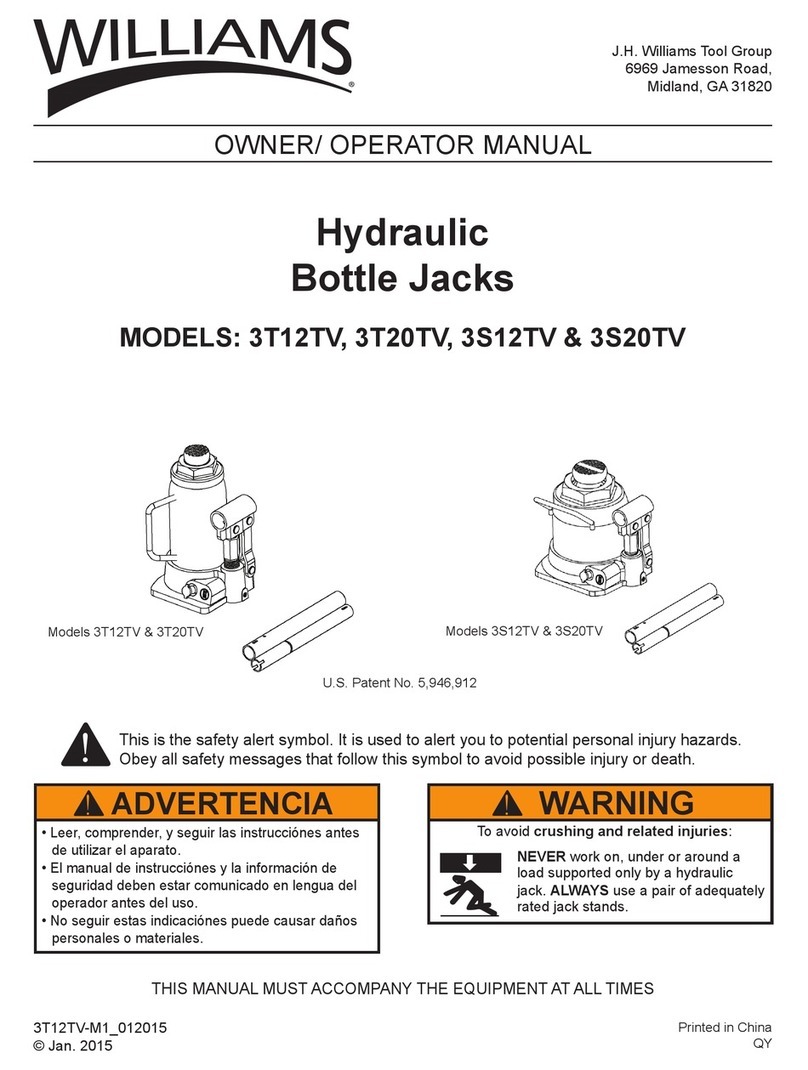
Williams
Williams 3T12TV Owner's/operator's manual
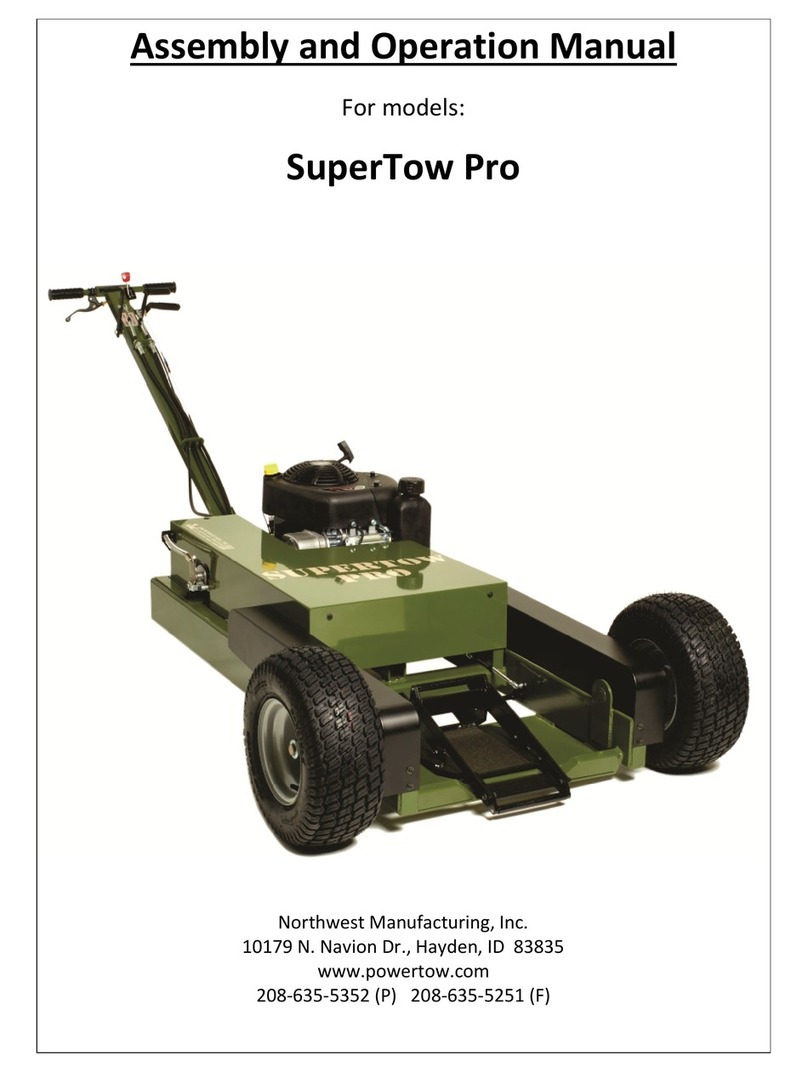
Northwest
Northwest SUPERTOW PRO Assembly and operation manual
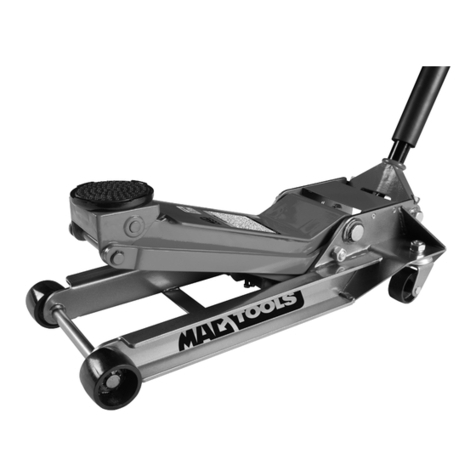
MAC TOOLS
MAC TOOLS JSA350LR owner's manual
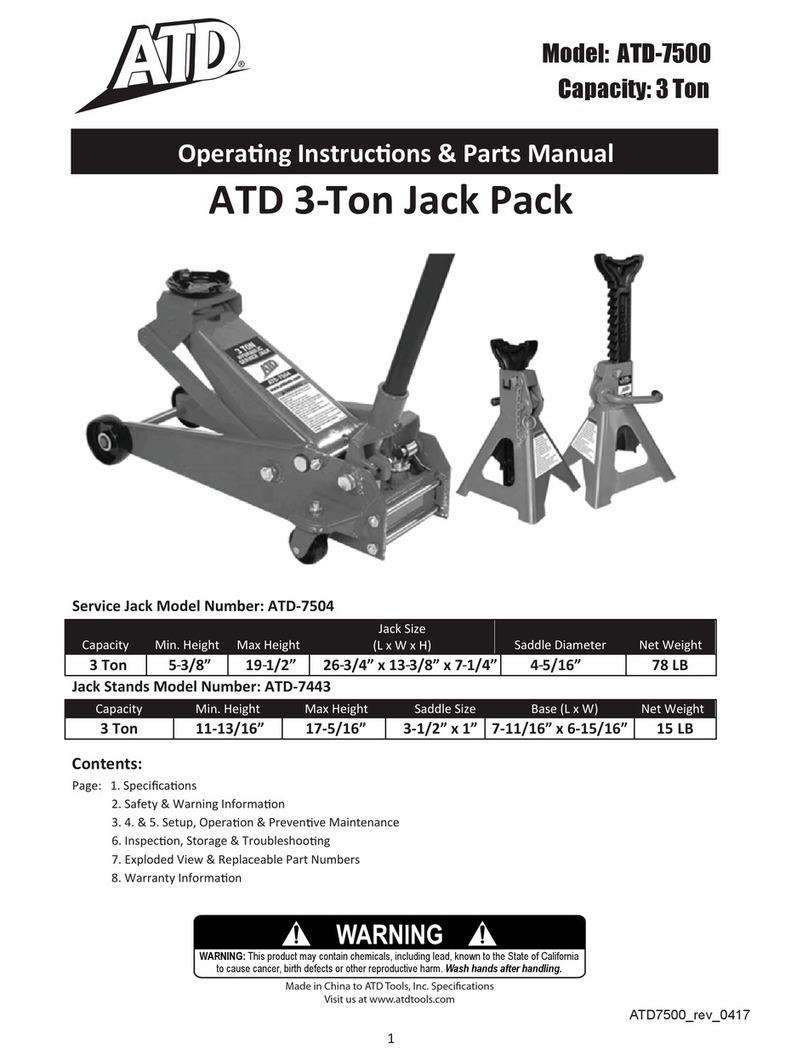
ATD Tools
ATD Tools ATD-7500 Operating instructions & parts manual
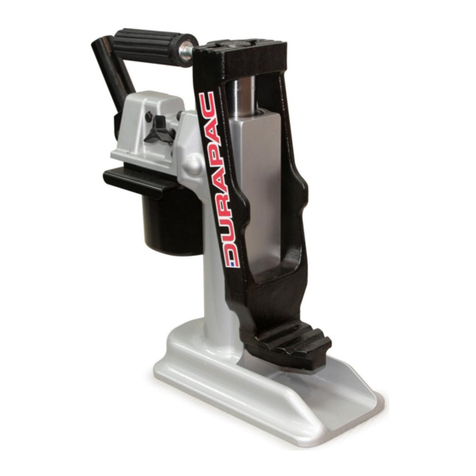
Durapac
Durapac DRJ-10 instruction manual

BIG RED JACKS
BIG RED JACKS T42002 owner's manual


